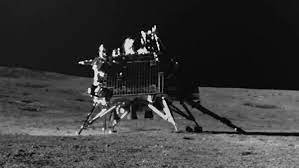Chandrayaan-3, India’s ambitious lunar mission, has completed its historic journey, marking significant achievements despite the challenges it faced. The mission aimed to explore the lunar south pole and gather valuable data about the Moon’s surface and composition. On August 23, Chandrayaan-3 achieved a soft landing near the lunar south pole, and its Pragyan rover immediately got to work, conducting experiments and sending back data to Earth.
Since its touchdown, the Pragyan rover made groundbreaking discoveries, including the presence of chemicals like sulfur and oxygen in lunar soil. It also recorded temperature fluctuations and collected a wealth of other data over a two-week period before going into a temporary “sleep” mode as lunar night descended.
The hope was that both the lander and rover would survive the frigid lunar night and awaken on September 22 for the dawn of a new lunar day. This would have allowed the mission to power up its solar-energy devices and continue transmitting signals back to Earth. However, as of today, there has been no sign of any such awakening.
Despite the lander and rover’s incredible resilience, this outcome was not entirely unexpected. Chandrayaan-3 was not designed to withstand the extreme cold of lunar nights, which can plummet to temperatures below minus 200 degrees Celsius. Additionally, the Moon’s thin atmosphere does not regulate temperature variations between night and day, a feature unique to Earth.
In light of these challenges, the fact that the Pragyan rover and lander successfully operated for two weeks after the soft landing is a testament to India’s scientific prowess. Crucial experiments were conducted during this period, making the mission a resounding success.
As this lunar mission concludes, it serves as a reminder of the stark differences between the Earth and the Moon. Earth’s atmosphere plays a vital role in moderating temperature extremes, ensuring a habitable environment for life. However, this balance is under threat from global warming, driven by industrial emissions that trap heat.
In summary, Chandrayaan-3’s journey has been a triumph of scientific achievement, yielding invaluable insights into the lunar surface. While the rover and lander did not survive the lunar night, their contributions to lunar science are significant, emphasizing the importance of continued exploration and understanding of our celestial neighbor.
News Summary:
- Chandrayaan-3’s Pragyan rover made groundbreaking discoveries of sulfur and oxygen in lunar soil during its two-week operational period.
- The mission concluded as the lander and rover did not awaken from their lunar night “sleep.”
- Chandrayaan-3 demonstrated India’s scientific prowess despite harsh lunar conditions.
- The mission highlights the unique role of Earth’s atmosphere in moderating temperature extremes, a contrast to the Moon’s harsh environment.
- The importance of addressing global warming on Earth is underscored as it threatens this delicate balance

Leave a Reply